Seasons – Spring 2018
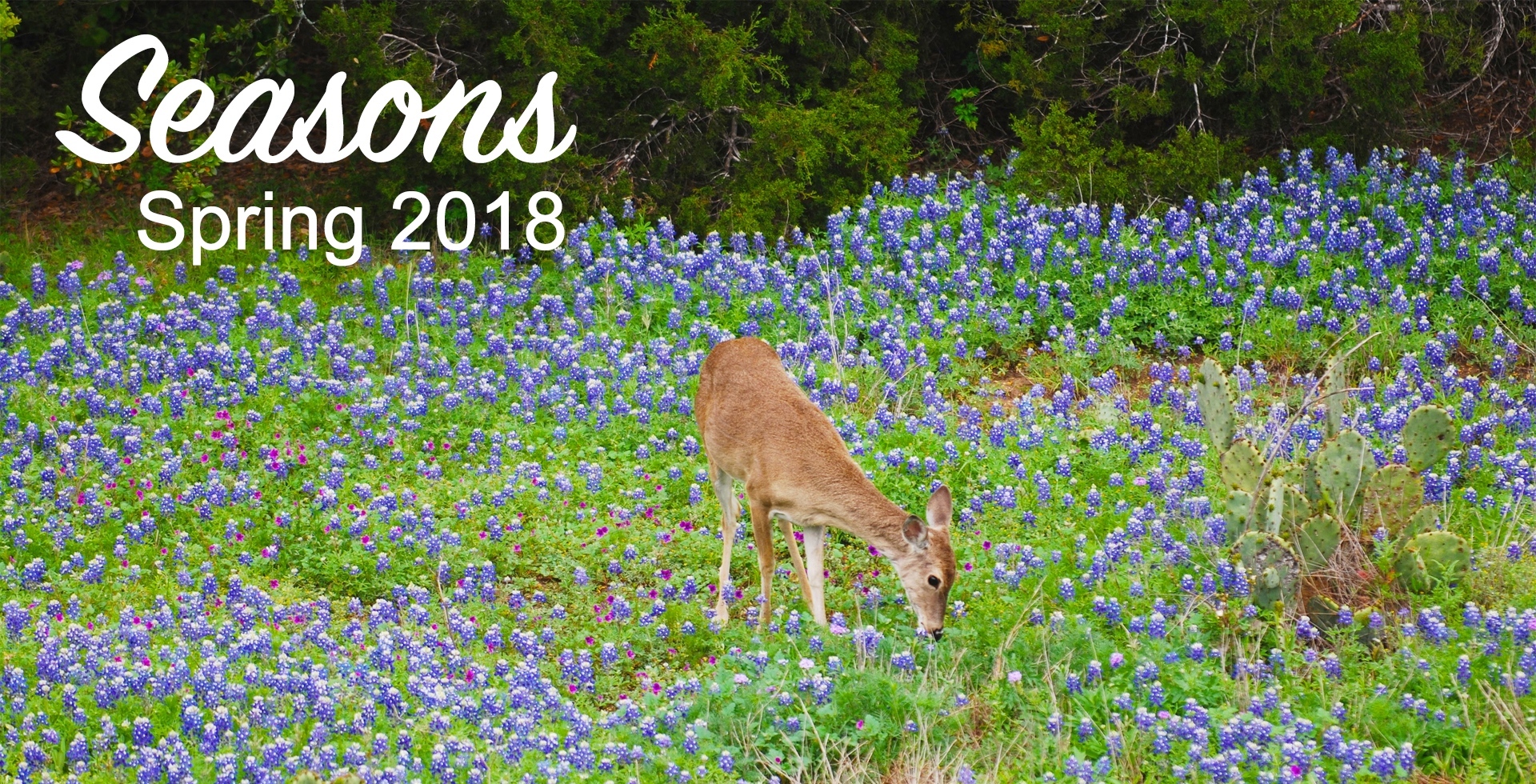
From the Plateau Land & Wildlife Management Team,
There’s no doubt about it, spring is a time to get things done. While other seasons are ripe with reasons to put things off, spring signifies a clean, fresh start. The sun shines longer, the rains bring life to the plants that wilted away during the winter, and the young wildlife begins to flourish.
In this issue of Seasons, you’ll find a checklist of activities perfect for springtime, the importance of recovering and conserving Texas native land and wildlife, a what-not-to-do when it comes to summertime invasive species and the importance of having an up-to-date and complete estate plan, which should include your property and all of its assets.
Spring is so important and beautifully productive for our property and its wildlife. It’s a time of work, but a time of great reward and enjoyment for so many creatures, including us. We hope you all have a chance to get out and enjoy your property. Take some time to prepare for summer and take advantage of the spring season and all that comes with it – your wildlife will thank you.
We hope you’re all able to make the most out of this spring… it only comes once a year! Enjoy this issue and thank you for sharing another season with us.
Until next season and Seasons,
The Plateau Team
Table of Contents
Recovering Americas Wildlife Act: A Monumental Step in Wildlife Funding for Texas
Spring Wildlife Management Activities Checklist
Billion Dollar Day on the Lake
Introducing Andrew Eberly & Avalon Powell
Announcing Plateau’s New Website
Service Spotlight: Spring Breeding Bird Survey
The Importance of a Complete Will
Is it Time for a Change?
Plateau Land Group Featured Listing
Recovering Americas Wildlife Act: A Monumental Step in Wildlife Funding for Texas
By David Riley, Staff Biologist I and James Hall, Staff Biologist II
September 2nd, 1937, Franklin D. Roosevelt signed on a dotted line, which enacted one of the greatest conservation funding acts in the history of the United States. The Federal Aid in Wildlife Restoration Act, also known as the Pittman-Robertson Act, essentially allocated the 11% excise tax that is placed on firearms and ammunition back to the states to be used for wildlife conservation.
Over the years the Pittman-Robertson Act has seen many revisions to include other taxes on handguns and archery equipment. The Dingell-Johnson Act of 1950 was a similar law, produced to obtain funds from sportfishing and boating in order to aid in management and restoration of state fisheries. Last year we celebrated the 80-year anniversary of the Pittman-Robertson Act. Since its induction, over $14 billion dollars has been placed in Wildlife Restoration Trust Fund for conservation. However, since the PR and DJ Acts, there have been very few successful attempts at allocating more funds to wildlife conservation.
That is until the Recovering America’s Wildlife Act (RAWA & H.R. 5650) was conceived and introduced to the House of Representatives in July 2016. Unfortunately, the bill never made it out of committee and died well before a vote. The bill, now known as H.R. 4647, has been reintroduced in the 2017-2018 session and is currently in committee hearings. Recovering Americas Wildlife Act would allocate an annual distribution to the states, including potentially $50-65 million to Texas. This would nearly double current state funding, making massive strides towards encouraging the restoration of flora and fauna species of greatest conservation need.
Funding of this magnitude is always followed by the question, where is the money going to come from? The simple answer is the $1.3 billion would come from existing revenue from oil, energy, gas, and mineral fees on federally operated lands. Currently, the money is allocated to the Department of Treasury, but RAWA would reallocate these funds to the individual states based on size and need. The funds would be controlled by the states fish and wildlife agencies, such as Texas Parks and Wildlife Department.
Another critical question – how is the money going to be spent? For government entities, additional funding can be utilized for expanding research programs, land allocation for parks and preserves, and outreach aimed at benefiting declining species. However, state government-funded programs, while highly important and often successful, are bound by conciliation with competing interests, face bureaucratic red-tape, and frequently aim to provide recreational activities in public space.
In Texas, these programs are often fluctuating and severely underfunded, and in many cases, largely allocated solely for the benefit of game animals and sportfish. Compounding the problem, these public lands account only for a fraction of the open space in Texas. In this state, the burden of land management remains undoubtedly on the shoulders of the private landowner.
It is generally accepted that habitat loss and degradation are one of the chief causes of declining species. Due to the state being more than 95% privately owned, proper land stewardship must be encouraged. Financial incentives will be the principal motivator for these landowners to manage their properties for the benefit of non-game species. Once implemented by federal or state initiatives, these incentive programs can then be further encouraged by private sector groups who have greater flexibility in providing the services needed by the landowner. Many consulting firms are in a unique position to offer technical guidance and assist with the implementation of management concerns.
For example, Plateau Land & Wildlife Management is in a unique business niche in central Texas, dealing primarily with consultations regarding 1-d-1 wildlife management valuation. Landowners incur enormous tax savings on their properties by managing them specifically for wildlife, as they would under the agricultural valuation. While we all rely on agriculture to provide food and other products for human consumption, not all lands are easily tamed for sustainable production. The Edwards Plateau provides excellent examples of marginally productive agricultural land which would be better suited as wildlife habitat.
 Another incentive program is the promotion of habitat for migrating Monarch butterflies. Several of these programs target landowners who are paid to establish pollinating and host species such as antelopehorn milkweed, a vital plant that the Monarch requires for propagation. While indisputably beneficial, this activity focuses on only one species and does not provide long-term financial security for ranchers who ultimately must decide between livestock and wildlife management options.
Another incentive program is the promotion of habitat for migrating Monarch butterflies. Several of these programs target landowners who are paid to establish pollinating and host species such as antelopehorn milkweed, a vital plant that the Monarch requires for propagation. While indisputably beneficial, this activity focuses on only one species and does not provide long-term financial security for ranchers who ultimately must decide between livestock and wildlife management options.
Furthermore, few of these programs address the fragmentation and incongruity of management practices across the landscape. Large-scale and incentive-based land preservation is paramount, where unadulterated habitats can be conserved, monitored, and properly managed. While the government purchase of land is prohibitively expensive and relatively rare, existing landowners can be incentivized through mitigation funding or tax incentives to conduct stewardship activities or create conservation easements for long-term protection of the state’s most sensitive habitat. Landowners are then no longer burdened with the need to fragment their land. For a perennial program to succeed, money must continue to be funneled to those that control ownership and ultimately management of the land, under the guidance of natural resource professionals in both the private and public sectors.
Regardless of the mechanism or the entity that manages it, the current reality is that conservation funding is not expected to trend upwards. This year’s legislative session and the subsequent years may prove critical in the protection of our valued natural resources. Each state will implement different approaches for maximizing the efficiency of those dollars. Providing the tools and inspiration necessary to affect change will one day be reflected upon by future generations as the crucial point in the protection of that which we exploit.
Back to TopBack to Top
Spring Wildlife Management Activity Checklist
By Kameron Bain, Landowner Account Manager Intro Content
Here in Dripping Springs, we are already seeing the first signs of spring. Bluebonnets are beginning to bloom, birds are starting to arrive and all is looking a little brighter. With comfortable temperatures and days getting longer, now is a perfect time to take care of some of your wildlife management activities. In spring there are several important activities to be done so enjoy this wonderful time of year and get an activity done at the same time!
- Nest boxes & Supplemental Shelter – Spring birds are starting to arrive so you need to clean out your nest boxes ASAP
- Predator Control
- Imported Red Fire Ant Control
- Brown-headed cowbirds during breeding bird seasons
- Erosion control
- Supplemental water
- Spring Breeding Bird Census
- Re-seeding native grasses
Billion Dollar Day on the Lake
By Nick Fisher, Wildlife Services Technician
Invasive species – an organism that causes harm to the environment, the economy, and/or degrades the health of humans.
As stewards of the land, we are responsible for making sound decisions to counterbalance our impacts, if not improve the natural world around us. The paradigm with humans and the natural world is that for us to want to preserve it and provide conservation efforts, we must responsibly find ways to enjoy it.
Although unintentionally in many cases, as humans expand more and more into untouched areas, we bring with us non-native and invasive species. Introductions of invasive species that have no natural predators and usually reproduce at exponential rates are a major issue in wildlife management. As a landowner, your first thought is likely feral hogs, ashe juniper (native invasive), or even invasive red fire ants – all of which started causing issues to natural habitats years ago.
But when you take a break from keeping your own property under control and enjoy a day on the lake, did you realize you could be spreading invasive species?!
Imagine this…
It’s a calm summer morning in early July and the boils on the lake from bass leaping out of the water are music to your ears. Depressingly enough, your Mastercraft, the S.S. Speidel has yet to see a day on Lake Travis this summer and your Shakespeare hasn’t caught anything but dust recently. Filling up the Yeti and collecting your anxious buddies doesn’t take long, but by the time you reach the ramps, the sun is already beaming off the line of fiberglass boats as they make their debuts into the water, flaunting every curve as if stepping onto the red carpet. The smell of sunscreen brings back good memories of your last fishing trip as you flashback to last summer, but you don’t remember the mussels that seem to smother out the solid objects near the water’s edge. The sheer density of the striped mollusks is incredible.
Not a cloud shows up on this day and the temperature is nearing the triple digits. Your last beverage must have evaporated because you don’t remember finishing it so it’s time to call it quits for the day. It’s time to load up the boat and head back to reality until next weekend. The warm lake water on your shorts dries quickly and the cool water of the Barton Springs Pool sounds refreshing before the drive home… little do you know, you are contributing to the spread of an invasive species.
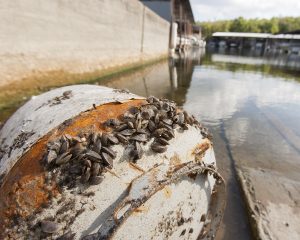
Zebra mussels©, Courtesy of Texas Parks & Wildlife and Earl Nottingham
The larvae of a Zebra Mussel can attach itself to just about anything and spreads at an alarming rate once introduced into a new body of water. The mussel is a non-native from the Black and Caspian Seas that has quickly threatened and begun harming our waterways. The mollusk absorbs phytoplankton, as do native mollusks, but a single zebra mussel can produce up to a million larvae in its lifetime starting at about age two. The amount of phytoplankton that is consumed by zebra mussels is enough to clarify bodies of water resulting in increased temperatures of the water. An increase in water temperature and a decline in the number of resources for native species results in a decline in abundance of natives species found.
Not only are you seeing less fish on your leisure day on the lake, but these mussels are attaching to boat propellers, covering beaches, and clogging water intake pipes into cities. In fact, NPR describes zebra mussels as the “poster child” for invasive species in Texas.
With another $6.3 million provided from the legislature to Texas Parks and Wildlife for aquatic invasive control, the department will be attempting to control the spread, funding research for new solutions, as well as reaching out to provide more knowledge on the issue. Anywhere zebra mussels are found, recreationists have the opportunity, and a responsibility, to help control the spread. Cleaning, draining, and drying your boat and equipment can help prevent the spread of the mussels to new areas and can keep you from committing a Class C misdemeanor and a fine of up to $500 for transporting or possessing zebra mussels for the first offense.
The amount of money allocated to TPWD for such invasive aquatic species control has to be divided into control for other such invasive species including giant salvinia, which causes an equally damaging ecosystem as the mussels by blocking out sunlight completely by floating on the surface as a dense cover. Often blocking agricultural pipes or making it difficult to travel through, salvinia reproduce by means of fragmentation, doubling area covered in just weeks.
According to TPWD, zebra mussels are now present in 14 bodies of water in the state, as well as three others that are suspected to have them, after a report in February claimed larvae have been found in Lady Bird Lake. With summer right around the corner, boats in the water are the biggest concern for spreading the mussels but be conscious of all equipment and materials that may be in contact with water bodies that have a history of containing zebra mussels.
You can help by cleaning your boat, trailer, and all equipment (pressure washers and hot soapy water works best), removing all foreign objects, plants or animals, draining all water from the boat from anywhere it has collected, and drying for at least a week before accessing a new body of water. Another way to help is by reporting any sightings (with photos and GPS coordinates if possible) to Texas Invasives online or Texas Parks and Wildlife. In order to continue to enjoy the natural world, everyone has to do their part in making responsible land steward-like decisions every day.
“The hope of the future lies not in curbing the influence of human occupancy – it is already too late for that – but in creating a better understanding of the extent of that influence and a new ethic for its governance.” ― Aldo Leopold, Game Management
Back to TopBack to Top
Introducing Andrew Eberly & Avalon Powell
Plateau is happy to welcome Andrew and Avalon to the team! Andrew has joined the products and services team as a wildlife services technician, and Avalon has joined the marketing department as a marketing assistant.
Andrew Eberly
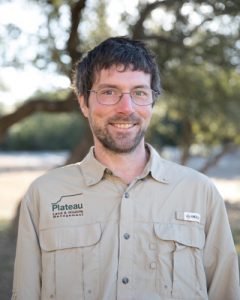
Andrew grew up in eastern Pennsylvania and spent much of his time roaming through the woods looking for birds or fishing at Crum Creek. This early exposure to the natural world and love for ecology always inspired Andrew to seek new ecosystems to explore and it eventually drew him away from the Philadelphia area.
Andrew studied wildlife biology at the University of Vermont and then headed west to pursue seasonal work as a wildlife technician. He surveyed for breeding birds from national parks in the Chihuahuan Desert to the Northern Great Plains. Birds have been Andrew’s primary focus, mostly because he grew up birding with his dad, but he has always tried to branch out and learn as much about plants and other types of animals as well.
People ask how Andrew ended up in Central Texas and it’s hard to come up with a simple answer. He has always been drawn to the transition between the humid east and the deserts of the west and is excited to have found a place in that zone with its own unique character.
Andrew is also excited for the chance to broaden his experience in the world of conservation by working with private landowners in areas that are transitioning from agriculture to wildlife management. Most of his work has been on relatively remote public lands and although he has lived in many beautiful places, he believes conservation goals cannot be met without taking into account the vast wealth of private land out there and the wellbeing of the people who own it.
Avalon Powell

Avalon joins the Plateau family of companies as their new marketing assistant. Coming from a long line of West Texas cattle ranchers, she has a true love and appreciation for wildlife. Avalon’s parents were landowners in Arkansas where she spent a large amount of her childhood trekking the hills and exploring for native flora and fauna. She brings her passion for nature to her work with Plateau.
After graduating from Texas State University in the fall of 2016 with an M.S. in Journalism, and a dual concentration in digital and multimedia journalism, Avalon began her marketing profession with Renee Trudeau & Associates as their communications assistant. She followed her passion for event coordination and social media marketing and is now happy to join the Plateau family.
As the inheritor of her family land in Arkansas, Avalon understands the importance of protecting landowner rights—preserving the integrity and history of her family’s property. She is excited to work with a family of companies that works to preserve that as well.
Back to TopBack to Top
Announcing Plateau’s New Website
Plateau is happy to announce the launch of our new website! After months of hard work and dedication, we’re happy to see you here reading our first issue of Seasons 2018.
Our hopes for the new site was to keep the same great information, but make it more of a resource for anyone in wildlife management or wanting to find out more. We spent hours upon hours redesigning with landowners in mind – simplifying navigation, consolidating pages and making it easier to inquire about Plateau products and services.
Along with the new look and feel, we welcome some new features and pages – we encourage everyone to visit and explore our new site after reading Seasons. We will be consistently updating our content with helpful information, articles and blogs, newsletters and announcements.
Going forward, we plan to incorporate more video content, infographics and information that benefits anyone who owns or works with those who own land in Texas. As we continue to improve, tweak and add to our new site, please let us know if there’s anything you like, dislike, can’t find or would like to see. We welcome any questions or feedback you’d like to share with our team – please do so by filling out the form on our contact page.
We’re really proud of our new Plateau website and hope and feel as though it will enable the experience you’re looking for when you visit Plateau. You can always find us here: plateauwildlife.com.
Back to TopBack to Top
Service Spotlight: Spring Breeding Bird Survey
By Kameron Bain, Landowner Account Manager
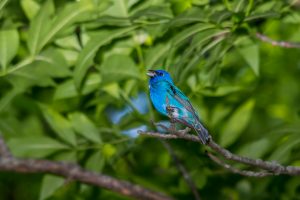
Indigo bunting singing from a branch against leaves
Spring is a favorite time of year not only for all of us here at Plateau but for many of our landowners as well. We’re anxiously awaiting the return of the spring songbirds, and in Texas, we’re lucky to witness the largest migration in the entire country!
Nest boxes have been cleaned, water tables checked and feeders filled – all of the work has been done and now it’s time to fully enjoy this wonderful season! And even better yet, one of our favorite spring pastimes is also a wildlife management activity!
A Spring Breeding Bird Census is performed March 15 through June 30 to identify migratory and breeding birds taking residence on your property. The information captured can be used to identify important breeding and nesting habits, track population trends and create management plans for year-round use. Maybe the best part though? One wildlife management activity completed in just one morning.
Contact us today for more information or to schedule a spring breeding bird survey on your property with one of Plateau’s highly-skilled birders.
Back to TopBack to Top
 The Importance of a Complete Will
The Importance of a Complete Will
By Margaret Menicucci, Attorney at Braun & Gresham, PLLC
I have never met a client who says they want their Will to distribute only a part of their estate, and then they want the family to figure out the rest through four years of costly litigation. That is exactly what happened to a Texas family in a recent case before the Fort Worth Court of Appeals. The contested Will gave all the personal property to the decedent’s niece but was silent about the decedent’s real property.
The gaps in this Will led to litigation between the niece and the decedent’s children. The niece thought the real property was given to her along with the personal property; the children thought it passed to them through the Texas heirship law. The kids won. Even though a Will existed, it was incomplete in passing all of the assets, so a part of the estate passed intestate (as though the decedent died without a Will).
Most people want simplicity in the document that distributes their estate, but over-simplifying leads to gaps that create woeful complexity and cost at probate. Instead of just simplicity, the goal should be a balance of clear direction regarding your wishes, and court-tested language that aids the executor, beneficiaries, and others in implementing those wishes. You risk losing that balance when using a do-it-yourself (internet download) Will or rely on a hand-written Will. Turning to a qualified estate planner who takes the time to understand you, your family, and your assets will help you achieve the balance.
At Braun & Gresham, we want our clients to develop an estate plan that protects their assets during their lives, reflects their goals for passing on their assets, values, and legacy, and allows those goals to be realized when they die.
If you have any questions or would like to discuss your own estate plan today, contact Margaret at (512) 894-5426.
Back to TopBack to Top
I s it Time for a Change?
s it Time for a Change?
By Megan Herrington, Realtor® at Plateau Land Group
The days are getting longer and the grass is getting greener; spring is right around the corner! Before too long, it will be time to mow, spray, fertilize, clear, and plant- not to mention, pay taxes- all part of landowner duties. If the idea of toiling over these projects for another year makes your heartbeat quicken or your feet feel like cinderblocks- or if the idea of having extra green in your pocket rather than your pasture excites you, it may be time to consider a change. I’ve personally worked with many clients who have experienced this dilemma and found a way to better their lives and financial situation.
Charli and Robert did an amazing job of keeping up their show property for 40+ years: tending to the elaborate gardens, managing the wildlife, and maintaining two beautiful homes. Over the years, however, the constant work began to feel less like a pleasure and more like a daily struggle. Instead of letting the property deteriorate or continuing to feel overwhelmed, the couple made the choice to free up their time and resources by exchanging their beloved property for a smaller, more manageable homestead closer to doctors and grandchildren. They sold their property and had plenty of funds to purchase a new home and reinvest the rest for their family. Their decision to free themselves from a stressful situation has benefited the entire family.
Daniel and his family have owned a piece of farmland in Williamson County for over 75 years that his parents left to him and his sisters years ago. Since then, they have leased it to a farmer to cover the taxes, and each has moved to different parts of the state with their families. They have not seen the property in years and none of the kids have any desire to become farmers. The memories of their parents farming this land are special and can never be replaced. Daniel worries that if they sell, they would be doing some disservice to his family’s legacy… what would his parents say after all? After some soul-searching and contemplating what he believed the land meant to his parents, he decided to offer his blessing in exchanging this piece of family farmland for another property that the family would use and enjoy together at the coast. Daniel’s sisters also felt this decision to downsize into a more functional and useful property would honor their parents and be a place their children could gather with the next generation. The land was always about family- whether it was a source of income or a place to gather and make memories.
Of course, neither of these decisions were easy to make in the beginning. Years of work and memories are deeply rooted in these pieces of land, but there is a time when letting go of what was and embracing what is to come is rejuvenating. Change doesn’t have to mean selling an entire property though; many people choose to simply downsize by selling a portion to a neighbor or new owner, leaving a more manageable-sized property that they can fully enjoy.
As spring approaches and new life surrounds us, I invite you to embrace change and rejoice in the energy that spurs this movement. The next time that feeling of worry or stress washes over you when thinking about the present, ask yourself, is it time for a change?
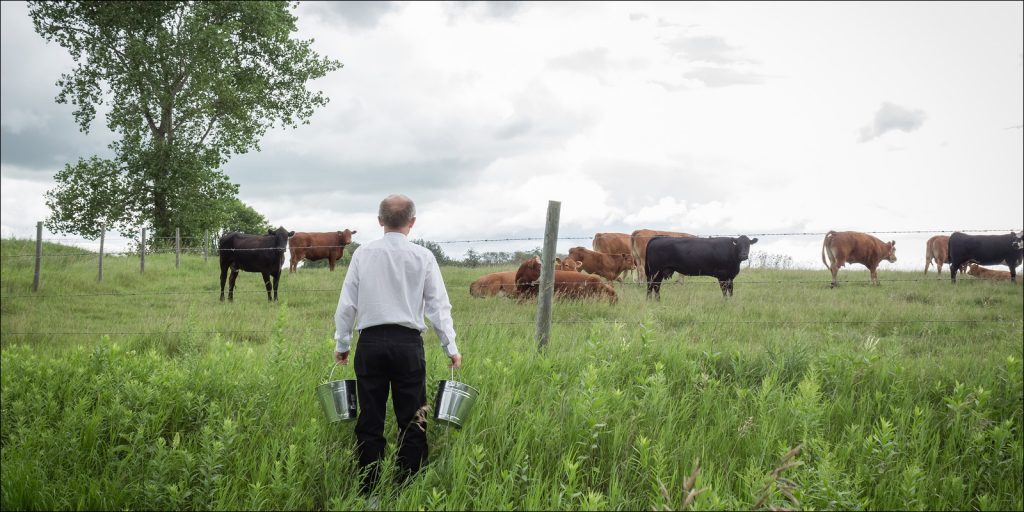
Landownership is rewarding but oftentimes challenging, especially with larger properties, or those far from amenities, family, and friends. If your property is causing you more stress than satisfaction, it may be time for a change, whether it be simply downsizing to a more manageable piece of land, or moving closer to the things that matter most to you.
Back to TopBack to Top
Plateau Land Group Featured Listing
Recreation and Legacy Ranch, Johnson City, Blanco County, TX, 240 Acres, $1,848,000
This property is the quintessential offering to a recreational buyer who wants an affordable piece of the Texas Hill Country. Situated on the north side of the Pedernales River Valley, these 240 acres boast stunning sunsets, improved ranch roads, and great wildlife habitat. Over 850 feet of beautiful Spring Creek, a main tributary to Grape Creek and the Pedernales River, and almost 3,000 feet of FM 1320 road frontage round out this unique ranch.
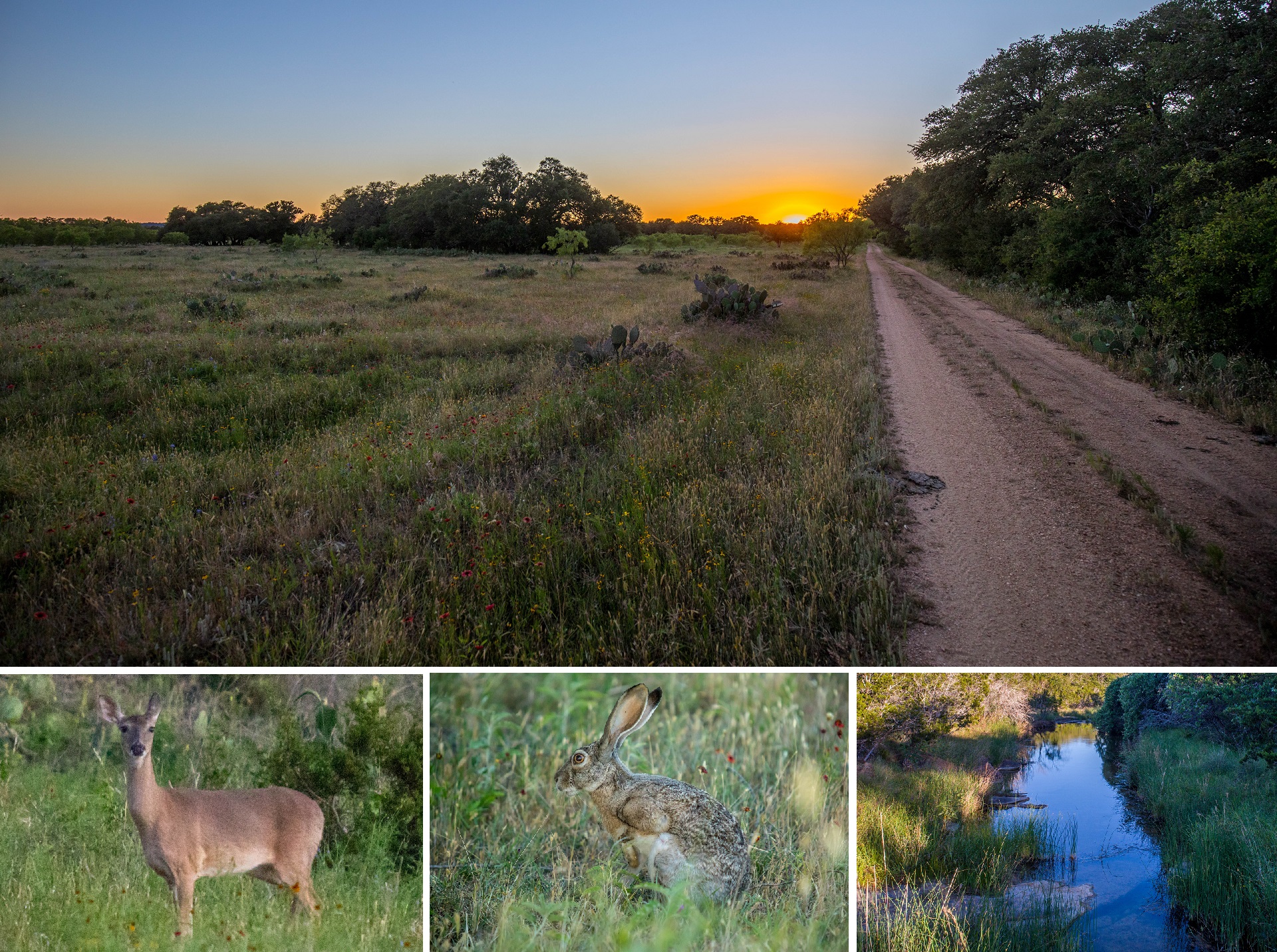
View all of Plateau Land Group’s listings.
Click here to receive PLG’s newest listings by email.
Back to TopBack to Top






Sorry, the comment form is closed at this time.